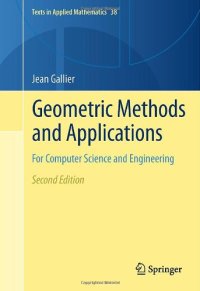
Ebook: Geometric Methods and Applications: For Computer Science and Engineering
Author: Jean Gallier (auth.)
- Tags: Geometry, Computer Imaging Vision Pattern Recognition and Graphics, Control Robotics Mechatronics, Optimization
- Series: Texts in Applied Mathematics 38
- Year: 2011
- Publisher: Springer-Verlag New York
- Edition: 2
- Language: English
- pdf
This book is an introduction to the fundamental concepts and tools needed for solving problems of a geometric nature using a computer. It attempts to fill the gap between standard geometry books, which are primarily theoretical, and applied books on computer graphics, computer vision, robotics, or machine learning.
This book covers the following topics: affine geometry, projective geometry, Euclidean geometry, convex sets, SVD and principal component analysis, manifolds and Lie groups, quadratic optimization, basics of differential geometry, and a glimpse of computational geometry (Voronoi diagrams and Delaunay triangulations). Some practical applications of the concepts presented in this book include computer vision, more specifically contour grouping, motion interpolation, and robot kinematics.
In this extensively updated second edition, more material on convex sets, Farkas’s lemma, quadratic optimization and the Schur complement have been added. The chapter on SVD has been greatly expanded and now includes a presentation of PCA.
The book is well illustrated and has chapter summaries and a large number of exercises throughout. It will be of interest to a wide audience including computer scientists, mathematicians, and engineers.
Reviews of first edition:
"Gallier's book will be a useful source for anyone interested in applications of geometrical methods to solve problems that arise in various branches of engineering. It may help to develop the sophisticated concepts from the more advanced parts of geometry into useful tools for applications." (Mathematical Reviews, 2001)
"...it will be useful as a reference book for postgraduates wishing to find the connection between their current problem and the underlying geometry." (The Australian Mathematical Society, 2001)
This book is an introduction to the fundamental concepts and tools needed for solving problems of a geometric nature using a computer. It attempts to fill the gap between standard geometry books, which are primarily theoretical, and applied books on computer graphics, computer vision, robotics, or machine learning. This book covers the following topics: affine geometry, projective geometry, Euclidean geometry, convex sets, SVD and principal component analysis, manifolds and Lie groups, quadratic optimization, basics of differential geometry, and a glimpse of computational geometry (Voronoi diagrams and Delaunay triangulations). Some practical applications of the concepts presented in this book include computer vision, more specifically contour grouping, motion interpolation, and robot kinematics. In this extensively updated second edition, more material on convex sets, Farkas’s lemma, quadratic optimization and the Schur complement have been added. The chapter on SVD has been greatly expanded and now includes a presentation of PCA. The book is well illustrated and has chapter summaries and a large number of exercises throughout. It will be of interest to a wide audience including computer scientists, mathematicians, and engineers. Reviews of first edition:"Gallier's book will be a useful source for anyone interested in applications of geometrical methods to solve problems that arise in various branches of engineering. It may help to develop the sophisticated concepts from the more advanced parts of geometry into useful tools for applications." (Mathematical Reviews, 2001)"...it will be useful as a reference book for postgraduates wishing to find the connection between their current problem and the underlying geometry." (The Australian Mathematical Society, 2001)